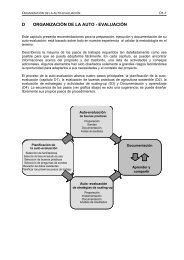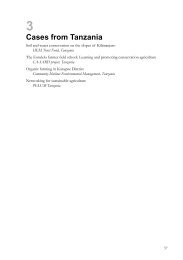Adaptation of small scale farmers to climatic risks in India - Sustainet
Adaptation of small scale farmers to climatic risks in India - Sustainet
Adaptation of small scale farmers to climatic risks in India - Sustainet
You also want an ePaper? Increase the reach of your titles
YUMPU automatically turns print PDFs into web optimized ePapers that Google loves.
To <strong>of</strong>fset crop failure aris<strong>in</strong>g from ra<strong>in</strong>fall variability and unpredictability, <strong>farmers</strong> cultivate several<br />
hardier (or drought-<strong>to</strong>lerant) types <strong>of</strong> the same crop species. Many prefer the use <strong>of</strong> local gra<strong>in</strong>s such<br />
as millets and sorghums that are more drought-resistant than<br />
many maize or wheat varieties. In ra<strong>in</strong> deficient years, such<br />
crops fare considerably better <strong>in</strong> term <strong>of</strong> yields, than the more<br />
water demand<strong>in</strong>g species. Dur<strong>in</strong>g <strong>in</strong>terviews, women farmer<br />
provided the <strong>in</strong>formation on the existence <strong>of</strong> <strong>in</strong>digenous wheat<br />
known as deshi gehu (local wheat), or lal gehu (red wheat).<br />
Deshi or <strong>in</strong>digenous wheat has just about vanished from this<br />
region and was not planted <strong>in</strong> any <strong>of</strong> the visited villages.<br />
Accord<strong>in</strong>g <strong>to</strong> these elderly women, this wheat variety grows<br />
with far less water than modern wheat, and might be life sav<strong>in</strong>g<br />
<strong>in</strong> drought years.<br />
Shift<strong>in</strong>g cropp<strong>in</strong>g patterns and delayed sow<strong>in</strong>g: Due <strong>to</strong> reduced<br />
water availability, some <strong>farmers</strong> have s<strong>to</strong>pped grow<strong>in</strong>g crops,<br />
which require greater amount <strong>of</strong> water such as cot<strong>to</strong>n and<br />
wheat. They have successfully shifted cropp<strong>in</strong>g patterns <strong>to</strong><br />
species requir<strong>in</strong>g less water. They started grow<strong>in</strong>g cum<strong>in</strong><br />
seeds, gram, black gram, and some oilseed crops like mustard.<br />
A diversity <strong>of</strong> crop types and varieties are grown <strong>in</strong> rotation and<br />
<strong>in</strong> different areas <strong>of</strong> farm properties, which spreads the risk <strong>of</strong><br />
los<strong>in</strong>g an entire year's production. The important crops grown<br />
<strong>in</strong> the mixed cropp<strong>in</strong>g system are Pearl millet, Sesame, Green<br />
gram, Sorghum and Maize.<br />
By necessity, <strong>farmers</strong> shift their sow<strong>in</strong>g periods accord<strong>in</strong>g <strong>to</strong><br />
the weather. Earlier, <strong>farmers</strong> were tak<strong>in</strong>g decisions about their<br />
cropp<strong>in</strong>g pattern and sow<strong>in</strong>g time on Krishi Panchang<br />
(agricultural vedic calendar), which <strong>in</strong>cludes a climate forecast<br />
for an entire year based on planetary positions. Such traditional<br />
weather forecast is not work<strong>in</strong>g appropriately anymore and<br />
28<br />
We plant less wheat and<br />
no chickpeas anymore as<br />
these crops failed <strong>to</strong>o<br />
<strong>of</strong>ten. We shifted cropp<strong>in</strong>g<br />
patterns <strong>to</strong> local varieties<br />
<strong>of</strong> pulses, green gram,<br />
millets and mustard, which<br />
are less water demand<strong>in</strong>g.<br />
Rotat<strong>in</strong>g green gram and<br />
mustard works very well<br />
and both crops have a<br />
ready market. We use the<br />
money <strong>to</strong> buy additional<br />
wheat for our rotis”,<br />
expla<strong>in</strong>s Ram Prasad Jat<br />
from Kaanwarpura village.<br />
<strong>farmers</strong> adapted <strong>to</strong> chang<strong>in</strong>g weather conditions by tak<strong>in</strong>g more spontaneous decisions. In the absence<br />
<strong>of</strong> efficient weather forecast such decisions are however risky and many <strong>farmers</strong> reported <strong>to</strong> be<br />
helpless fac<strong>in</strong>g <strong>in</strong>creased weather variability. Where possible, some <strong>farmers</strong> are re-<strong>in</strong>troduc<strong>in</strong>g native<br />
grasses for pastur<strong>in</strong>g. These grasses are drought resistant and even support rotational graz<strong>in</strong>g,<br />
reduc<strong>in</strong>g thereby the fodder penury.<br />
28




